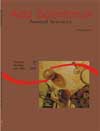<b>Replacing corn with citrus pulp in diets with high rates of concentrate on the degradability and rumen kinetics</b> - DOI: 10.4025/actascianimsci.v31i2.5403
Keywords:
high concentrate, liquid kinetics, rumen degradation
Abstract
Four Nellore steers, with 400 ± 12 kg weigh and rumen cannulae, were utilized to evaluate the effect of replacement levels of corn by citrus pulp on diet degradability and rumen kinetics. The experimental treatments were the substitution levels of corn by citrus pulp: 0, 40, 60 and 80%. The study evaluated DM, NDF and CP degradability of the diets, the DM and NDF of corn and citrus pulp, as well as rumen volume, liquid and solid passage and liquid per kg of DM intake per hour (turnover). The degradability was performed in the 14th experimental day; the incubation was at 0, 3, 6, 9, 12, 24 and 48 hours. The addition of citrus pulp in replacement of corn, increased the DM degradation up to the 60% level (p < 0.05). The CP and NDF degradation increase with the high substitution of corn to pulp (p < 0.05). The liquid flow per day and the liquid flow for DM intake per day, showed linear effect (p = 0.0177 and p = 0.0286), being highest to the 80% treatment. The substitution was favorable to diet degradation and rumen kinetics to level 60%. Corn substitution by citrus pulp at levels up to 60% negatively affects the degradation of diets with high concentrateDownloads
Download data is not yet available.
Published
2009-08-11
How to Cite
Nogueira, K. A., Valinote, A. C., Nogueira Filho, J. C. M., Leme, P. R., & Silva, S. da L. e. (2009). <b>Replacing corn with citrus pulp in diets with high rates of concentrate on the degradability and rumen kinetics</b> - DOI: 10.4025/actascianimsci.v31i2.5403. Acta Scientiarum. Animal Sciences, 31(2), 155-160. https://doi.org/10.4025/actascianimsci.v31i2.5403
Issue
Section
Ruminant Nutrition
DECLARATION OF ORIGINALITY AND COPYRIGHTS
- I Declare that current article is original and has not been submitted for publication, in part or in whole, to any other national or international journal.
The copyrights belong exclusively to the authors. Published content is licensed under Creative Commons Attribution 4.0 (CC BY 4.0) guidelines, which allows sharing (copy and distribution of the material in any medium or format) and adaptation (remix, transform, and build upon the material) for any purpose, even commercially, under the terms of attribution.
Read this link for further information on how to use CC BY 4.0 properly.
0.9
2019CiteScore
29th percentile
Powered by 








































